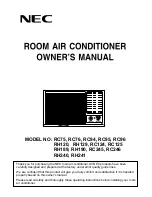
Page 14
1 − Connect manifold gauge set to the service valve ports :
low pressure gauge to
vapor
line service valve
high pressure gauge to
liquid
line service valve
2 − Connect micron gauge.
3 − Connect the vacuum pump (with vacuum gauge) to the
center port of the manifold gauge set.
4 − Open both manifold valves and start the vacuum
pump.
5 − Evacuate the line set and indoor unit to an
absolute
pressure
of 23,000 microns (29.01 inches of mercury).
During the early stages of evacuation, it is desirable to
close the manifold gauge valve at least once to deter-
mine if there is a rapid rise in
absolute pressure
. A rap-
id rise in pressure indicates a relatively large leak. If this
occurs, repeat the leak testing procedure.
NOTE − The term
absolute pressure
means the total
actual pressure within a given volume or system, above
the absolute zero of pressure. Absolute pressure in a
vacuum is equal to atmospheric pressure minus vacu-
um pressure.
6 − When the absolute pressure reaches 23,000 microns
(29.01 inches of mercury), close the manifold gauge
valves, turn off the vacuum pump and disconnect the
manifold gauge center port hose from vacuum pump.
Attach the manifold center port hose to a nitrogen cylin-
der with pressure regulator set to 150 psig (1034 kPa)
and purge the air from the hose with nitrogen. Open the
manifold gauge valves to break the vacuum in the line
set and indoor unit. Close the manifold gauge valves.
CAUTION
Danger of Equipment Damage.
Avoid deep vacuum operation. Do not use compres-
sors to evacuate a system.
Extremely low vacuums can cause internal arcing and
compressor failure.
Damage caused by deep vacuum operation will void
warranty.
7 − Shut off the nitrogen cylinder and remove the manifold
gauge hose from the cylinder. Open the manifold gauge
valves to release the nitrogen from the line set and in-
door unit.
8 − Reconnect the manifold gauge to the vacuum pump,
turn the pump on, and continue to evacuate the line set
and indoor unit until the absolute pressure does not rise
above 500 microns (29.9 inches of mercury) within a
20−minute period after shutting off the vacuum pump
and closing the manifold gauge valves.
9 − When the absolute pressure requirement above has
been met, disconnect the manifold hose from the vacu-
um pump and connect it to an upright cylinder of R−410A
refrigerant. Open the manifold gauge valves to break the
vacuum from 1 to 2 psig positive pressure in the line set
and indoor unit. Close manifold gauge valves and shut
off the R−410A cylinder and remove the manifold gauge
set.
C − Charging
NOTES −
R−410A refrigerant cylinders are rose−colored. Re-
frigerant should be added through the vapor valve
in the liquid state.
Certain R−410A cylinders are identified as being
equipped with a dip tube. These allow liquid refrig-
erant to be drawn from the bottom of the cylinder
without inverting the cylinder. DO NOT turn this type
cylinder upside−down to draw refrigerant.
IMPORTANT
Use table NO TAG to perform maintenance checks.
Table NO TAG is not a procedure for charging the sys-
tem. Minor variations in these pressures may be due to
differences in installations. Significant deviations
could mean that the system is not properly charged or
that a problem exists with some component in the sys-
tem.
This system is charged with R−410A refrigerant which oper-
ates at much higher pressures than R−22. The installed liq-
uid line filter drier is approved for use with R−410A. Do not
replace it with components designed for use with R−22. This
unit is NOT approved for use with coils which use
capillary
tubes as a refrigerant metering device.
Factory Charge
Units are factory charged with the amount of R−410A refrig-
erant indicated on the unit rating plate. This charge is based
on a matching indoor coil and outdoor coil with 15 ft. (4.6 m)
line set. For varying lengths of line set, refer to table 4 for re-
frigerant charge adjustment.
TABLE 4
Refrigerant Charge per Line Set Lengths
Liquid Line
Set Diameter
Oz. per 5 ft. (g per 1.5 m) adjust
from 15 ft. (4.6 m) line set*
3/8 in. (9.5 mm)
3 ounce per 5 ft. (85 g per 1.5 m)
*If line length is greater than 15 ft. (4.6 m), add this amount.
If line length is less than 15 ft. (4.6 m), subtract this
amount.
IMPORTANT
Mineral oils are not compatible with R−410A. If oil
must be added, it must be a polyol ester oil.
The compressor is charged with sufficient polyol es-
ter oil for approved line set lengths.
Units Delivered Void of Charge
If the system is void of refrigerant,
clean the system using
the procedure described below.
1 − Use dry nitrogen to pressurize the system and check for
leaks. Repair leaks, if possible.





































